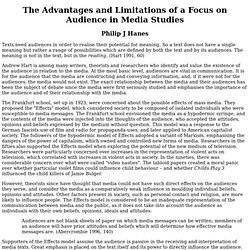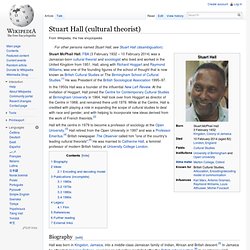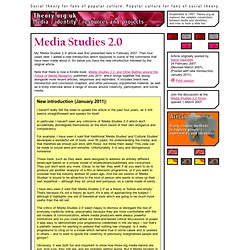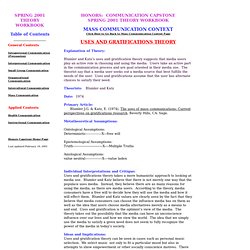

AS&A Level Key Concepts — Audience. Audience theory provides a starting point for many Media Studies tasks.

Whether you are constructing a text or analysing one, you will need to consider the destination of that text (i.e. its target audience) and how that audience (or any other) will respond to that text. Remember that a media text in itself has no meaning until it is read or decoded by an audience. For GCSE, you learned how audience is described and measured . Now you need a working knowledge of the theories which attempt to explain how an audience receives, reads and responds to a text. Over the course of the past century or so, media analysts have developed several , ie theoretical explanations of how humans ingest the information transmitted by media texts and how this might influence (or not) their behaviour. 1.
Dating from the 1920s, this theory was the first attempt to explain how mass audiences might react to mass media. 2. Audience in Media Studies. Texts need audiences in order to realise their potential for meaning.

So a text does not have a single meaning but rather a range of possibilities which are defined by both the text and by its audiences. The meaning is not in the text, but in the reading. (Hart 1991, 60) Andrew Hart is among many writers, theorists and researchers who identify and value the existence of the audience in relation to the media. At the most basic level, audiences are vital in communication. Stuart Hall - Encoding/decoding (cultural theorist)
Stuart McPhail Hall, FBA (3 February 1932 – 10 February 2014) was a Jamaican-born cultural theorist and sociologist who lived and worked in the United Kingdom from 1951.

Hall, along with Richard Hoggart and Raymond Williams, was one of the founding figures of the school of thought that is now known as British Cultural Studies or The Birmingham School of Cultural Studies.[1] He was President of the British Sociological Association 1995–97. Audience in Media Studies. Audience in Media Studies.
Encoding/Decoding. Daniel Chandler Encoding/Decoding Structuralist semioticians tend to focus on the internal structure of the text rather than on the processes involved in its construction or interpretation. Where those working within this tradition do theorize beyond the text, they tend to argue that communication (particularly mass communication) is a primary process of reality construction and maintenance whereby positions of inequality, dominance and subservience are produced and reproduced in society and at the same time made to appear 'natural'.
The 'New Critics', W K Wimsatt and M C Beardsley, whilst not structuralists, advanced the formalist argument that meaning lay the text and defined as 'the affective fallacy' the notion that the meaning of a poem depended on the 'subjective' responses of the reader, which they saw as 'a confusion between the poem and its (what it and what it )' (Wimsatt & Beardsley 1954, 21) .
The sends a message to the . Referential context. Denotation, Connotation and Myth. Daniel Chandler Denotation, Connotation and Myth Beyond its 'literal' meaning (its denotation), a particular word may have connotations: for instance, sexual connotations. 'Is there any such thing as a ? ' quipped the comic actor Kenneth Williams (we all know that 'a thing is a phallic symbol if it's longer than it's wide', as the singer Melanie put it). Audience in Media Studies. AS&A Level Key Concepts — Audience. Media Studies 2.0 – Article on future of media studies by David Gauntlett at Theory.org.uk.
My 'Media Studies 2.0' article was first presented here in February 2007.

Then four years later, I added a new introduction which responds to some of the comments that have been made about it. So below you have the new introduction followed by the original article. Note that there is now a Kindle book, Media Studies 2.0, and Other Battles around the Future of Media Research, published July 2011, which brings together this essay alongside more recent articles, responses and rejoinders. It includes brand new introduction and conclusion chapters, and other previously unpublished material, as well as a lively interview about a range of issues around creativity, participation, and social media. Original article (2007):
MAKING IS CONNECTING - David Gauntlett [Vol4, #13] “An Ambling Dinner Conversation” A review of Making is Connecting by David Gauntlett.
![MAKING IS CONNECTING - David Gauntlett [Vol4, #13]](http://cdn.pearltrees.com/s/pic/th/featured-connecting-gauntlett-28439996)
Review by Josh Mayo. Making is Connecting David Gauntlett. Paperback: Polity, 2011. Buy now: [ Amazon ] Most readers understand (unconsciously, if not consciously) the dual-nature of sociological studies like Making is Connecting: simply put, this kind of writer is always preoccupied with both informing and evaluating cultural trends. David Gauntlett is an odd duck for media studies. Throughout the text, Gauntlett argues that “making is connecting,” that artistry and craft can – and, thanks to emerging digital platforms, does today – bring people together. Up to this point, his thesis is nothing controversial; in fact, it almost verges on a truism. Uses and Gratifications Theory - Mass Communication Context. MASS COMMUNICATION CONTEXTClick Here to Go Back to Mass Communication Context Page Explanation of Theory:
